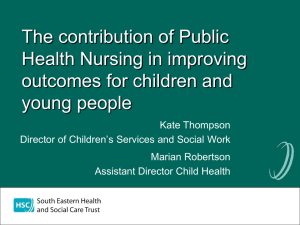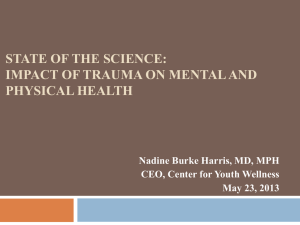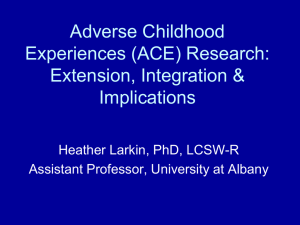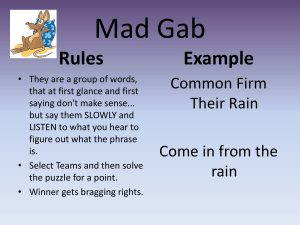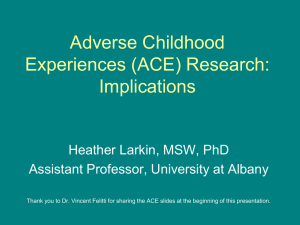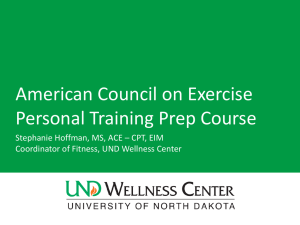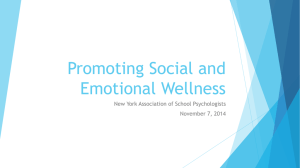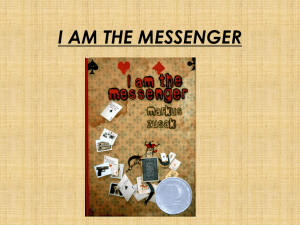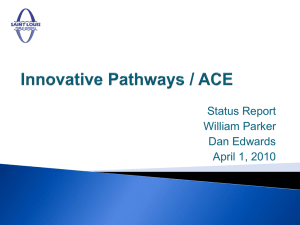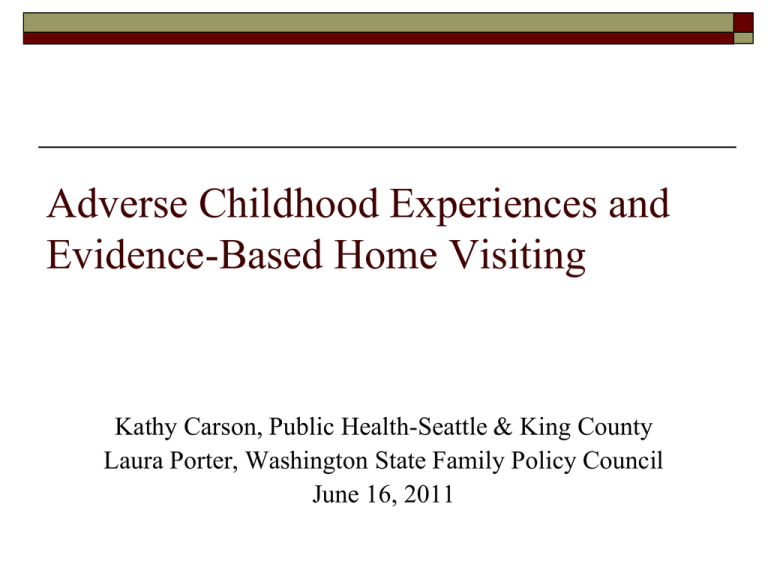
Adverse Childhood Experiences and
Evidence-Based Home Visiting
Kathy Carson, Public Health-Seattle & King County
Laura Porter, Washington State Family Policy Council
June 16, 2011
Overview
New evidence about the impact of Adverse
Childhood Experiences on lifelong health
Increased interest and evidence about home
visiting as a strategy for improving outcomes
How can understanding ACE improve home
visiting practice?
Question for you
Are you familiar with the ACE Study findings?
Yes
No
In the feedback box on the left of your screen, indicate
your answer to each question now.
If you have experience with ACE you’d like to share, use
the chat box on the lower left anytime during the
presentation. We’ll review your responses during the
discussion.
Question for you:
Are you applying the ACE Study findings in
your work?
Yes
No
ADVERSE CHILDHOOD
EXPERIENCES
The Most Powerful Determinate of the Public’s Health
REDUCING ACEs - HIGH
LEVERAGE
Reliably Predicts Improved Health, Safety, & Productivity,
Lowers Need for High Cost Services
WASHINGTON LEADS THE NATION
ADVERSE CHILDHOOD EXPERIENCES
The Most Powerful Determinate of the Public’s Health
Abuse and Neglect
1. Child physical abuse
2. Child sexual abuse
3. Child emotional abuse
4. Neglect
Indicators of Family Dysfunction
5. Mentally ill, depressed or suicidal person in the home
6. Drug addicted or alcoholic family member
7. Witnessing domestic violence against the mother
8. Parental discord – indicated by divorce, separation, abandonment
9. Incarceration of any family member
ACE Score: the number of categories of adverse childhood experience to which a
person was exposed.
ACEs INFLUENCE VIA BIOLOGIC IMPACT ON
NEURODEVELOPMENT
BRAIN
Hormones, chemicals &
cellular systems prepare
for a tough life in an evil
world
INDIVIDUAL
•Edgy
•Hot temper
•Impulsive
•Hyper vigilant
•“Brawn over
brains”
BRAIN
Hormones, chemicals &
cellular systems prepare
for life in a benevolent
world
INDIVIDUAL
•Laid back
•Relationshiporiented
•Thinks things
through
•“Process over
power”
OUTCOME
Individual &
species survive
the worst
conditions.
TRAUMATIC
STRESS
NEUTRAL
START
OUTCOME
Individual &
species live
peacefully in
good times;
vulnerable in
poor conditions
ACEs HAVE MANY IMPACTS THROUGHOUT THE LIFESPAN
PSYCHIATRIC
DISORDERS
CHRONIC
DISEASE
CRITICAL
& SENSITIVE
DEVELOPMENTAL
PERIODS
IMPAIRED
COGNITION
Early childhood, ages 7-9,
Pre-puberty,
Aging into adulthood
ADVERSE
CHILDHOOD
EXPERIENCE
MORE CATEGORIES – GREATER
IMPACT
Physical Abuse, Sexual Abuse
Emotional Abuse, Neglect
Witnessing Domestic Violence
Depression/Mental Illness in Home
Incarcerated Family Member
Substance Abuse in Home
Loss of a Parent
WORK/SCHOOL
Attendance, Behavior,
Performance
BRAIN
DEVELOPMENT
Electrical, Chemical,
Cellular Mass
Hard-Wired Into
Biology
ALCOHOL,
TOBACCO,
DRUGS
RISKY SEX
GENETICS
Including gender –
Remember that
experience triggers
gene expression
(Epigenetics)
OBESITY
ADAPTATION
CRIME
INTERGENERATIONAL
TRANSMISSION,
DISPARITY
POVERTY
IN THE LIVES OF WASHINGTONIANS:
ACEs ARE
COMMON
ACEs CO-OCCUR / CLUSTER
26% of adults report 3 or more ACEs
5% of adults have 6 or more ACEs
1 or 0 ACE
More 38%
ACE
62%
Among adults exposed to physical abuse,
84% reported at least 2 more ACEs
Among adults exposed to sexual abuse,
72% reported at least 2 more ACEs
A CLASSIC CAUSAL RELATIONSHIP
MORE ACEs = MORE HEALTH PROBLEMS
Response gets bigger
Dose-response is a direct
measure of cause & effect.
The “response”—in this
case the occurrence of the
health condition—is caused
directly by the size of the
“dose”—in this case, the
number of ACE categories.
Dose gets bigger
CHRONIC DISEASE
Current Smoking
Diabetes
28.5
30
25
Percent of Population
Percent of Population
BEHAVIORAL HEALTH
20.8
20
16.3
13.2
15
10.4
11.1
10
5
0
0
1
2
3
4 or 5
Number of ACE Categories
14
12
10
8
6
4
2
0
11.7
7.5
0
6,7, or 8
6
5.1
6
3.7
4
2
2
0
0
1
2
3
4 or 5
Number of ACE Categories
6,7, or 8
Percent of Population
Percent of Population
10.2
7.3
7.9
1
2
3
4 or 5
Number of ACE Categories
6,7, or 8
Cardio Vascular
Disease
10
8
7.5
6.1
Risk for HIV
12
8
9.4
10
8.1
8
6
6.7
4.9
5.6
5.6
4
2
0
0
1
2
3
4 or 5 6,7, or 8
Number of ACE Categories
DISABILITY
MENTAL HEALTH
30
25
20
15
10
5
0
Health Problems
Require Special
Equipment
24.5
19.3
11
14
15.5
7.3
0
1
2
3
4 or 5
Number of ACE Categories
6,7, or 8
Percent of Population
Percent of Population
Treatment for Mental
Health Condition
20
15
10
5
0
14.8
5.2
0
5.2
6.4
8.6
11.3
1
2
3
4 or 5
Number of ACE Categories
6,7, or 8
OLDER CHILDREN - High School Sophomores and Seniors
Population
Average
PHYSICAL & SEXUAL ABUSE AMONG WA ADULTS
All Adults
Women
25.5%, or 1.2m people:
either or both
28.6%: either or both
Among Parenting Adults,
26.1%
experienced child physical and/or sexual
abuse;
of those, 78% have 3 or more ACEs; 29%
have 6 or more ACEs
Among Parenting Women,
29.8%
experienced child physical and/or
sexual abuse
ACEs INFLUENCE VIA BIOLOGIC IMPACT ON
NEURODEVELOPMENT
BRAIN
Hormones, chemicals &
cellular systems prepare
for a tough life in an evil
world
TRAUMATIC
STRESS
INDIVIDUAL
•Edgy
•Hot temper
•Impulsive
•Hyper vigilant
•“Brawn over
brains”
OUTCOME
Individual &
species survive
the worst
conditions.
Normal Biologic Response to Toxic Stress
Can Make Parenting Harder
NEUTRAL
START
BRAIN
Hormones, chemicals &
cellular systems prepare
for life in a benevolent
world
INDIVIDUAL
•Laid back
•Relationshiporiented
•Thinks things
through
•“Process over
power”
OUTCOME
Individual &
species live
peacefully in
good times;
vulnerable in
poor conditions
HIGH CAPACITY COMMUNITIES
REDUCE PERCENT OF YOUNG ADULTS WITH ≥ 3 ACEs
POSITIVE ACE
TREND MEANS
REDUCED CASES:
Lack of Social
Support
38.4%
33.8%
35.2%
1888
29.6%
31.8%
Limited Activity (due
to disability)
5767
25.9%
Asthma
2128
Cancer
Heart Disease
37.9%
2828
23.6%
1004
Missed work due to 15.1%
1065
MI
Mental Illness (MI)
HIV
Youngest
Age Cohort
3845
1264
9.8%
Binge Drinking
3727
65+
Smoking
55-64
45-54
35-44
10874
InLow
Crisis
& Persistent
capacity
(n=1,537,995)
Thriving
High capacity
(n=1,255,900)
ACE REDUCTION IS A WINNABLE ISSUE
18-34
POPULATION
ATTRIBUTABLE
RISK
A large portion of
many health, safety
and
prosperity
conditions
is
attributable to Adverse
Childhood Experience.
ACE reduction reliably
predicts a decrease in
all of these conditions
simultaneously.
National Interest in Home Visiting
Evidence shows that when families volunteer to
receive home-based support in partnership with
trained professionals, their children are born
healthier and are less likely to suffer from abuse or
neglect.
Public investment in quality programs not only
fosters stronger families, it yields fiscal returns for
states of up to $5.70 per dollar.
Pew Center on the States
Federal Home Visiting Initiative
Included in Health Care Reform legislation
Funded at $1.5 Billion over 5 years
Mandatory funding not subject to the annual
appropriations process for 5 years
Began October 2010. After 5 years, must be
reauthorized or extended by Congress to continue.
Allocation to each state choosing to participate based
on population of children.
Critical Opportunity!
This is the chance to show that home visiting makes
a difference so funding will be continued.
75% of funding can only be used for programs that
have been evaluated and shown to be effective.
25% can be used for promising practices that have a
strong evaluation planned or in process.
Data collection to show outcomes is central to the
program.
What outcomes?
A bright future begins before birth
Stronger bonds, better lives
A foundation for lifelong learning
Healthy and safe at home
Lasting benefits beyond the home
Pew Center on the States
Interventions Build on One Another
Intervene early to reduce stress in pregnancy
Begin development of mother-infant bond in
pregnancy
Early mother-infant relationship forms basis for
development of empathy and ability to learn
Less stressed mother and baby are more socially
competent, which fosters learning and safety
Healthy pattern of relationship and safety carries
forward to relationships with others
Evidence-Based Home Visiting
Starts in pregnancy
Has sufficient intensity and duration to build trust
Establishes a trusting relationship between mother
and visitor – visitor keeps coming back regardless
Models a trusting relationship for the mother to the
infant
Majority of participants identify wanting to parent
differently than they were parented as a goal.
Why start in pregnancy?
Support women to improve their health practices
Get consistent prenatal care
Improve diet and activity
Reduce smoking
Reduce alcohol and drug use
Provide support to reduce the impacts of stress
on the mother and the fetus
Nurse Family Partnership
Sustainable Results:
Mothers
Verified reports of child
abuse and neglect
79%
Behavioral problems due
to drug or alcohol use
44%
Arrests
69%
LOW-INCOME, UNMARRIED
15-YEAR FOLLOW-UP
Nurse Family Partnership
Sustainable Results:
Adolescents
Arrests
54%
Convictions
69%
Sexual Partners
58%
Cigarettes Smoked
Number of days
consuming alcohol
28%
51%
15-YEAR OLDS BORN TO
UNMARRIED, LOW-INCOME
MOTHERS
Home Visiting and ACE
Acknowledgements:
Christopher Blodgett, Ph.D.
Washington State University Child & Family
Research Unit
Building a Response to ACE
Adversity is pervasive and transmitted across
generations
Trauma is a combination of exposure and the
process of adjustment once exposure occurs
Complex trauma risk:
Early exposure at times of foundational development
Multiple risks
Unpredictable and persistent
Who you love is who you may not be able to count on
Normal responses to extraordinary circumstances
Reasons to Hope
Resiliency buffers the effects of trauma.
Social support and resources are protective
factors that build resiliency at any age.
Safety can be created from multiple sources
and a little may go a long way.
Brain development is far more dynamic than
we used to think.
Language and cognition can form a buffer.
Building Resiliency
Resilience – positive adaptation despite
adversity
Goals across the lifespan:
In early childhood, successful secure attachment
In later childhood, mastery of school and
establishing meaningful peer and adult
relationships
Reduce exposure to vulnerability and increase
access to protective resources
Home visiting and Resiliency
Providing support and resources build
resiliency and are key activities in evidencebased home visiting programs.
Increasing knowledge of development and
support for parenting increase parents’ sense
of competence and increase resilience.
Cross-generation outcomes of home visiting
programs are evidence of increased resilience.
Specific Focus on Trauma?
HV outcomes may be improved by adapting practices to
incorporate more focus on trauma
Use ACE questions as a screen for who needs more intensive services
Educate parents about ACE so they understand the impact on their
life course and parenting
Use understanding of ACE to develop community resources and
supports for families
“The ACE questionnaire is a tool to help clients understand
their own lives and to inspire them to make decisions to
protect their children from having a high ACE score.”
Quen Zorrah, NFP PHN
What can we do?
Educate our workforce about ACE and
developmentally sensitive periods
Use evidence-based interventions whenever possible
Evolve screening practices for ACE as a definition
of risk
Assess the value of adopting a trauma focus in our
work with targeted populations
Adoption and adaptation of practice can occur within
existing capacity and with new resources
Discussion
What ideas do you have about how to use the
ACE information to improve home visiting
practice?
Maternal and Child Public Health
Leadership Training Program
University of Washington, Seattle
Past training sessions can be viewed at
http://www.nwcphp.org/training/courses/maternal-child-health-mchtraining-for-professionals
The Northwest Bulletin, a newsletter focused on issues affecting the
health of children and families living in the Northwest Region and
Alaska, is available at http://depts.washington.edu/nwbfch/
Supported in part with grant #T76 MC 00011 from the Maternal and Child Health Bureau (Title
V, Social Security Act.

